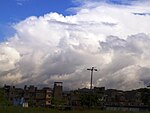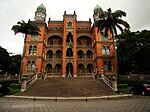Escola Nacional de Belas Artes

Escola de Belas Artes (School of Fine Arts) is one of the centers of the Federal University of Rio de Janeiro and dates back to colonial times. A royal letter of Nov 20 1800 by John VI of Portugal established the Aula Prática de Desenho e Figura in Rio de Janeiro. It was the first institution in Brazil systematically dedicated to teaching the arts. During colonial times, the arts were mainly of religious or utilitarian nature and were learnt in a system of apprenticeship. The Decree of Aug 12, 1816 created the Escola Real de Ciências, Artes e Ofícios (Royal School of Sciences, Arts and Crafts), which established an official education in the fine arts. Then it was renamed as the Academia Imperial de Belas Artes (Imperial Academy of Fine Arts), instituting a system of artistic education that would greatly influence the development of Brazilian art. On Nov 8 1890, the old Imperial Academy was transformed into the Escola Nacional de Belas Artes (National School of Fine Arts). In 1931, the School joined the University of Rio de Janeiro, the current Federal University of Rio de Janeiro.
Excerpt from the Wikipedia article Escola Nacional de Belas Artes (License: CC BY-SA 3.0, Authors, Images).Escola Nacional de Belas Artes
Praça Samira Nahid Mesquita, Rio de Janeiro Cidade Universitária
Geographical coordinates (GPS) Address Nearby Places Show on map
Geographical coordinates (GPS)
| Latitude | Longitude |
|---|---|
| N -22.8625 ° | E -43.225555555556 ° |
Address
Praça Samira Nahid Mesquita
Praça Samira Nahid Mesquita
21941-908 Rio de Janeiro, Cidade Universitária
Rio de Janeiro, Brazil
Open on Google Maps







